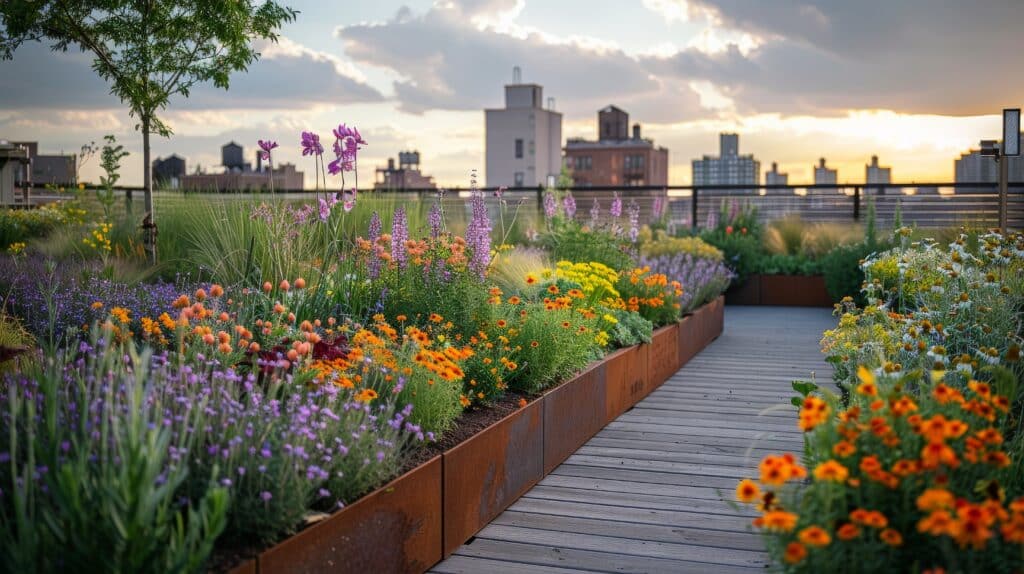Urban greening: what are the health risks for local populations?
- “Urban Greening” is one of the solutions being promoted to mitigate the effects of climate change.
- This approach can significantly reduce urban temperatures, improve the well-being of city dwellers and reduce energy consumption.
- Urban greening creates new ecological habitats, encouraging a greater variety of biodiversity in these environments, but it can also increase the health risks associated with vector-borne diseases.
- Vegetation management must be adapted to avoid health risks, such as dengue fever epidemics or the spread of disease-carrying ticks.
- Further research is essential to understand and minimise these risks, while maximising the benefits of urban greening.
Faced with the impact of climate change, urban greening is one of the adaptation solutions being promoted. By increasing the number of natural elements in cities, such as vegetation and water bodies, this approach helps to meet several of the Sustainable Development Goals (SDGs) adopted by the United Nations in 2015. Revegetation improves the well-being and health of city dwellers and reduces natural risks such as flooding.
In its latest report1, the Intergovernmental Panel on Climate Change (IPCC) highlights the major contribution it can make to reducing extreme heat in private and public spaces: thanks to the shade provided by trees, electricity consumption linked to residential air conditioning can be reduced by more than 30% at peak full stops. In Paris, a study shows that the air temperature in the streets can be reduced by more than 4°C if three adaptation measures are deployed: creating parks, insulating buildings, and using reflective materials2. Today, more than half the world’s population lives in cities. By 2050, this could have risen to two-thirds of the world’s population3.
How does urban greening affect biodiversity in cities?
Urbanisation erodes biodiversity. In the city, only the species that are most tolerant of urbanisation are present, and they are fairly homogeneous from one city to another. Bringing nature back into the city creates new ecological habitats that benefit other species. Planting trees, adding green facades or roofs, creating green spaces; there is a whole range of solutions for urban greening, with varying degrees of impact on biodiversity. Pollinating insects such as bees and butterflies benefit from the presence of urban park 4 and nectar-producing plants5. The creation of open meadows increases the richness of bird species6. Wild mammals such as wild boar can also penetrate cities when green corridors are created.
In an article published in March 20247, you highlight the emergence of health concerns linked to the urban greening. What are these risks?
The changes to urban biodiversity brought about by urban greening can increase the risk of the circulation of vector-borne diseases [editor’s note: infectious diseases transmitted by insects and mites, such as malaria, dengue fever, etc.]. Between 2009 and 2012, Madrid saw a resurgence in cases of leishmaniasis. This was linked to an increase in the populations of hares and flies, combined with greater use by residents of a recently developed urban forest on the outskirts of the city. In 2014, a dengue fever epidemic broke out in Tokyo: the link was established with visits to Yoyogi Park, where the tiger mosquito was very present thanks to the habitat provided by the park. But these health effects are highly location dependent. In Brazil, dengue is carried by another species of mosquito (Aedes aegypti), which finds the conditions it needs to thrive even in highly mineralised environments. Unlike in Tokyo, research in São Paulo has shown a reduction in dengue contamination in the city’s cooler, vegetated neighbourhoods8.
Are there other health risks associated with the introduction of mammals?
Mammals encourage the establishment of ticks in vegetated urban areas, which are themselves vectors of pathogens associated with diseases such as tick-borne encephalitis, haemorrhagic fevers (such as Crimean-Congo haemorrhagic fever) and Lyme disease. There has been an increase in the incidence of some of these diseases in urban areas on Staten Island (New York) and in Europe. A study in the journal Infection Ecology & Epidemiology9 reports several observations: a large number of ticks (136 every 100 metres) have been found in parks in Helsinki, with an infection rate of between 19% and 55% with the bacterium responsible for Lyme disease. In Bavaria (Germany), ticks carrying the parasite responsible for babesiosis are found in parks with permanent deer populations.

Isn’t the emergence of these diseases linked to the number of people visiting the parks?
Yes, this is one of the factors in the spread of disease. We’re seeing an increase in the use of vegetated areas in towns and cities. Increased human contact with biodiversity encourages a resurgence of vector-borne diseases. This complicates the management of green spaces by the public authorities and hampers public acceptance of urban green spaces. The Lyon metropolitan area is heavily invested in this issue. Lawns in urban parks are no longer cut short to promote biodiversity. The city has therefore installed signs to make walkers aware of the risks associated with ticks. They are regularly moved to maintain a high level of public awareness.
You draw attention to these growing health concerns. Is the health impact of urban greening really a new area of research?
The impact of greenery on respiratory diseases has been extensively studied. Urban greening reduces greenhouse gases, pollution, and heat. What’s more, parks encourage physical activity: all of which reduces cardiovascular risks. Conversely, greenery exposes people to pollen and increases the risk of respiratory allergies. But the risks associated with vector-borne diseases are less well studied. Urban ecology is a scientific discipline in which a great deal of work has been done. However, our knowledge is patchy: we still do not fully understand the impact of urban greening on specific diversity (the number of species in an environment) and functional diversity (the variety of species’ responses to change) in cities.
Should we stop urban greening?
No, that’s not the aim of our research. Urban greening brings benefits to people, particularly in view of the increased risk of heatwaves because of climate change. It is crucial to better understand the effects of urban greening to avoid related health risks. For example, what purpose does vegetation serve for mosquitoes, and does it play a role in their resting place? We don’t have the answer. What we do know is the value of increasing biodiversity in cities. For example, the dengue virus is carried by the tiger mosquito, but certain other species of mosquito do not spread it. When several species are present, the risk of infection is reduced.
Are there ways to incorporate urban greening while minimising health risks?
This is a research and urban planning question that we need to answer. Clearly, the watering of green spaces plays a major role: drip systems prevent the formation of small collections of water that are veritable breeding grounds for mosquitoes. We are also working on a research project in the suburbs of Montpellier aimed at developing an effective biological control strategy against the tiger mosquito. We are studying the most appropriate sites (those that favour mating) for releasing sterile male mosquitoes, depending on the vegetation. Other avenues could also be explored to identify the predatory species of the tiger mosquito from the faeces of birds and bats, to be able to encourage their presence with a view to biological control.















